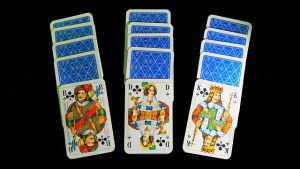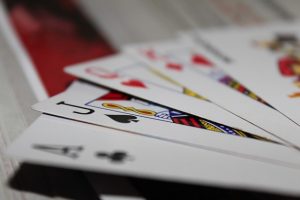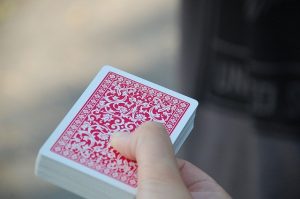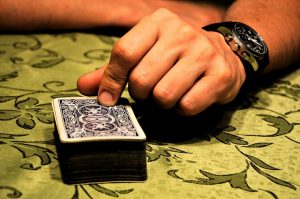Photo by Sergi Viladesau on Unsplash
I love card games as much as the next person. We wouldn’t have had a whole card games section on our site if at least one of us didn’t like a good card game. (Spoiler alert: everyone on the team loves card games, so I don’t know why I’m singling myself out here.)
But it doesn’t take special artwork and cards to make a fun game. In fact, there are tons more card games out there that you can play with an old-fashioned deck of playing cards. So if you’re bored of Go Fish, War, or Poker, you’re in the right place, because I’ve done a little digging to find ten card games with a regular deck of cards.
As a challenge, I tried to find card games I’ve never heard of before. Let’s see if you’ve heard of them.
Card Games with a Regular Deck of Cards
I Doubt It

First up in our list is a game all about bluffing. If you’re a skilled liar, this is the game for you.
In I Doubt It, the goal is to empty your hand of cards. At the beginning of the game, the dealer shuffles and hands out all the cards in a standard 52-card deck to the players.
Each round, players must put the cards they have for a specific type facedown in the middle of the table. For instance, the first round is the ace round, requiring each player to take turns laying down the aces they have in the middle of the table.
As you lay your cards down, announce how many of that type you’re putting in the middle. If you had one ace, you’d announce you’re putting down one ace in the first round. You’re required to lay cards down even if you don’t have the right ones, so this is where the bluffing comes in.
You can technically even lay down cards you have that aren’t of the specified type, if you want. I’m not sure what the strategic advantage to doing this is, though.
If a player doubts you’re laying down two fives when you’re supposed to, they can loudly proclaim, “I doubt it!” That’s when you take all the cards in the middle if you were bluffing. If you were telling the truth, your accuser takes all the cards in the middle.
Keep working your way up the card values for each round, going from ace to king, until someone manages to get rid of all their cards. The first player to do so wins.
- Difficulty: Easy
- Number of Players: 3+
- Recommended Age: 8+
- Additional Pieces: No
- Game Type: Shedding
Kings in the Corner

If you enjoy playing Solitaire, you’ll love Kings in the Corner. It’s basically a multi-player version of Solitaire, the old classic pretty much everyone has on their computer.
Your goal is to try and empty all the cards from your hand. To start, each player is given seven cards and then the rest of the deck is placed in the middle of the table.
Four cards are drawn from the middle and placed faceup on each side of the stockpile, forming a plus sign. Each of these four cards represents a foundation pile.
From that point on, players take turns trying to add to the foundation piles in a way just like with Solitaire. You can place cards on top of the foundations, as long as they are the opposite color and the next lowest in numerical value.
Each player makes as many moves as they can, adding to the foundation piles until they have no additional moves. Then the next player takes their turn. The first person to empty all the cards from their hand wins the round, and then points are tallied.
The point-counting process is a bit complicated, but you can read about it in more detail in this in-depth post about the rules.
- Difficulty: Medium
- Number of Players: 2+
- Recommended Age: 5+
- Additional Pieces: No
- Game Type: Solitaire-style, shedding
Nerts

Looking for a game that will get your pulse going? Then what you might be in the mood for is Nerts, which is frighteningly also called Racing Demon.
The best way to describe it is as another version of multiplayer Solitaire, in which each player or team has their own deck of cards. They also each have multiple foundation piles to add cards to, trying to diminish what’s called a Nerts pile.
Once a player has finished their Nerts pile, they get to shout, “Nerts!” which signals victory and ends the game. To be honest, I have no idea where the word “Nerts” came from, but speed Solitaire just kind of sounds interesting.
Its rules are surprisingly in-depth, so I’d check out the detailed rules when you get the chance. I’ve given you nothing but the barest overview here.
- Difficulty: Hard
- Number of Players: 2-8
- Recommended Age: 8+
- Additional Pieces: One deck of cards per player or team
- Game Type: Solitaire-style, competitive
Pazaak

Okay, so Pazaak isn’t a “real” card game in the sense that it was invented long ago by real people or something. I guess I don’t know how you’d define a “real” card game.
Anyway, if you’re a fan of the Star Wars Knights of the Old Republic (aka KOTOR) games, then you’re already aware of Pazaak. It’s basically just blackjack. Your goal is to try to get a numerical value from a group of cards as close to 20 as possible without exceeding that number.
There’s some setup involved with this one. You’ll need to remove all the face cards from a deck, then split the remaining cards into separate red and black decks. After that, remove any red cards that are higher than six and toss the jokers in the red deck.
With these decks set up, players take turns drawing until they get close or equal to 20. Certain cards allow you to add and subtract from your value. You play until someone wins three rounds. Check out this Pazaak guide for all the rules and helpful pictures.
- Difficulty: Hard
- Number of Players: 2+
- Recommended Age: 13+
- Additional Pieces: No
- Game Type: Casino
Make Ten

We’d strongly recommend Make Ten to you if you want a card game that you can use to teach math skills to your kids. It’s ultra-simple to play, surprisingly fun, and suitable for just about any age group.
Before playing, pull all the face cards out of your deck, then lay the remaining deck facedown on the table. All players draw five cards.
The goal of the game is to make as many different equations as possible that equal ten from the five cards in your hand. Once you’ve done so, the next player takes their turn.
As you go around the table a second time, players will draw new hands up to five, only keeping the numbers they didn’t use the previous time to make equations. The person who manages to use the most cards in equations (and therefore has the biggest discard pile) by the end of the game is the winner.
Read more about Make Ten in this guide.
- Difficulty: Easy
- Number of Players: 2+
- Recommended Age: 5+
- Additional Pieces: No
- Game Type: Other – educational
Read Next: Top 7 Best Card Games for Elementary Students
Screw Your Neighbor

The moment I saw a card game called “Screw Your Neighbor,” I knew I had to add it to this list. Is it a little-known card game? I’m not 100% sure, but I can say I’d never heard of it.
As you might have guessed, Screw Your Neighbor is all about throwing other players under the bus. Your mission is to have the highest card value, with aces being low and kings high.
Players sit in a circle and start the game with three lives. Each person is dealt a single card that they can look at. They get to choose to keep that card or swap with the person to their left.
With the exception of players who hold King cards, everyone gets the opportunity to swap. Everyone except the dealer swaps with each other, and the dealer for the round gets to swap with the top card of the deck if they so choose.
After swapping, everyone reveals their cards. The person with the lowest value loses a life. You keep playing in this manner until one person is left standing.
- Difficulty: Easy
- Number of Players: 3+
- Recommended Age: 5+
- Additional Pieces: No
- Game Type: Comparing game
Help Your Neighbor

After including a game called “Screw Your Neighbor,” I thought it would be a funny contrast to talk about one called “Help Your Neighbor.” This is a fairly simple game to play, but requires you have a bowl, a couple dice, and 10-15 poker chips for everyone playing.
You’ll need to have enough cards to give one suit to each player, so that means you might need two decks depending on how many people are playing. After removing the aces, Kings, and sevens from the decks, give the cards for one suit to each player.
Players then lay their cards faceup on the table in front of them in order. They each put poker chips in the bowl to start. Then, everyone takes turns rolling the two dice. If your number equals the value of one of the cards faceup in front of you, you get to flip that card over.
The goal of the game is to flip all your cards facedown first. The helping part comes from the fact that if anyone rolls the number for a card they have already flipped over, the next player gets to flip that card facedown instead.
I know those aren’t the most detailed instructions, but you can learn more about the game by reading this post. It also has some helpful and informative pictures.
- Difficulty: Easy
- Number of Players: 4-8
- Recommended Age: 5+
- Additional Pieces: Bowl, poker chips, pair of dice
- Game Type: Other
Red Dog

Do you consider yourself a betting person? Then Red Dog could be the perfect match for you because it’s all about rolling the dice (figuratively, not literally).
In Red Dog, players must show that they have a higher-valued card of the same suit than the one on top of the deck. Start by dealing four or five cards to each player based on the number of people playing.
Using the chips or counters you have on hand, players can create a pool of chips. On their turns, players must start by betting up to the number of chips in the pool. The dealer then reveals the top card of the deck and the player must show that they have a card of the same suit that’s higher in value.
If they win, the player regains their bet and the entire pot! However, if they lose, the player has to discard their entire hand unless they can add chips to the pool. Continue taking turns in this manner.
You can learn more about Red Dog on the official Bicycle cards site.
- Difficulty: Easy
- Number of Players: 2-10
- Recommended Age: 18+
- Additional Pieces: Chips or counters of some kind
- Game Type: Casino
California Speed

California speed probably sounds like an innuendo at first, but you may be pleasantly surprised to learn that it’s a simple matching card game. Plus, because it only allows for up to two players, it’s a great game for couples to play when they’re bored.
Start by shuffling and then giving half of a deck to both the players. Each player then lays four cards faceup in a row on the table in front of them.
Your mission is to get rid of all the cards in your hand. To do so, you must look for cards with matching values from the two rows of four laid down by both players. The colors and suits aren’t important.
For instance, suppose you see two 6’s in the rows of four laid out on the table. Once you spot this match, you hurry to cover it with two cards from your hand. If there are no matches among the eight cards anymore, the players will pick up their four respective piles, add them to bottom of their hand, and make four new piles.
The game continues until one player has no more cards in their hand. You can read this guide for handy pictures and instructions.
- Difficulty: Easy
- Number of Players: 2
- Recommended Age: 5+
- Additional Pieces: No
- Game Type: Matching, shedding
Egyptian Rat Slap

Egyptian Rat Slap, also known as Egyptian Rat Screw, is another game I picked for this list simply because it has a weird name. It’s another card game where speedy reflexes and spotting skills come in handy, which means I’d be terrible at it. You might be good at it, though.
Unlike the other games on this list, your goal is to win all the cards in the deck through rounds of value battles, like in the classic War card game we all played as kids. Start by dividing a deck of cards evenly between all players.
Players then take turns laying the top card from their hands faceup in the middle of the table. Keep doing this until someone puts a face or an ace card in the central pile.
When this happens, the next person must also play a face or an ace to win the current pile in the middle. If they can’t, the person who played the first face/ace wins the pile.
Except for slapping. Of course slapping has to be a part of this game. Players can slap the central pile to win it when a number of circumstances arise, which you can read about in the Bicycle guide for the game.
- Difficulty: Medium
- Number of Players: 2+
- Recommended Age: 8+
- Additional Pieces: None
- Game Type: Catch and collect
Wrap Up
I think many people rush to buy other card games for the novelty without realizing just how much you can do with a regular deck of playing cards. The ten games I touched on here are just the tip of an iceberg. There’s so much more beneath the surface if you’re willing to do even the most cursory amount of digging.
I tried to include a range of games for most ages and difficulty levels. Are there are any other card games you think we should explore? If so, leave a comment for me below.
